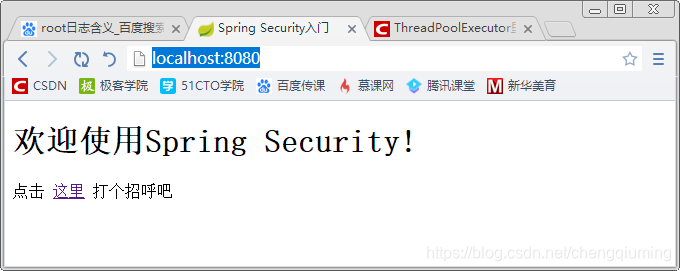版权声明:本文为博主原创文章,未经博主允许不得转载。 https://blog.csdn.net/chengqiuming/article/details/83713314
一 点睛
我们在编写Web应用时,经常需要对页面做一些安全控制,比如:对于没有访问权限的用户需要转到登录表单页面。要实现访问控制的方法多种多样,可以通过Aop、拦截器实现,也可以通过框架实现(如:Apache Shiro、Spring Security)。
本篇将具体介绍在Spring Boot中如何使用Spring Security进行安全控制。
二 实战
1 引入相关依赖
<dependencies>
<dependency>
<groupId>org.springframework.boot</groupId>
<artifactId>spring-boot-starter</artifactId>
</dependency>
<dependency>
<groupId>org.springframework.boot</groupId>
<artifactId>spring-boot-starter-test</artifactId>
<scope>test</scope>
</dependency>
<dependency>
<groupId>org.springframework.boot</groupId>
<artifactId>spring-boot-starter-web</artifactId>
</dependency>
<dependency>
<groupId>org.springframework.boot</groupId>
<artifactId>spring-boot-starter-thymeleaf</artifactId>
</dependency>
<!--引入security-->
<dependency>
<groupId>org.springframework.boot</groupId>
<artifactId>spring-boot-starter-security</artifactId>
</dependency>
</dependencies>2 新建控制器
package com.didispace.web;
import org.springframework.stereotype.Controller;
import org.springframework.ui.ModelMap;
import org.springframework.web.bind.annotation.RequestMapping;
import org.springframework.web.bind.annotation.RequestMethod;
@Controller
public class HelloController {
@RequestMapping("/")
public String index() {
return "index";
}
@RequestMapping("/hello")
public String hello() {
return "hello";
}
@RequestMapping(value = "/login", method = RequestMethod.GET)
public String login() {
return "login";
}
}3 安全配置
package com.didispace;
import org.springframework.beans.factory.annotation.Autowired;
import org.springframework.context.annotation.Configuration;
import org.springframework.security.config.annotation.authentication.builders.AuthenticationManagerBuilder;
import org.springframework.security.config.annotation.web.builders.HttpSecurity;
import org.springframework.security.config.annotation.web.configuration.EnableWebSecurity;
import org.springframework.security.config.annotation.web.configuration.WebSecurityConfigurerAdapter;
@Configuration
//通过@EnableWebSecurity注解开启Spring Security的功能
@EnableWebSecurity
//必须继承WebSecurityConfigurerAdapter
public class WebSecurityConfig extends WebSecurityConfigurerAdapter {
@Override
//重写该方法来设置一些web安全的细节
protected void configure(HttpSecurity http) throws Exception {
http
.authorizeRequests() //通过authorizeRequests()定义哪些URL需要被保护、哪些不需要被保护。
.antMatchers("/", "/home").permitAll() // /和/home不需要任何认证就可以访问。
.anyRequest().authenticated() //其他的路径都必须通过身份验证
.and()
.formLogin() //当需要用户登录时候
.loginPage("/login") //转到的登录页面
.permitAll()
.and()
.logout()
.permitAll();
}
@Autowired
public void configureGlobal(AuthenticationManagerBuilder auth) throws Exception {
auth
.inMemoryAuthentication() //在内存中创建了一个用户,该用户的名称为user,密码为password,用户角色为USER。
.withUser("user").password("password").roles("USER");
}
}4 启动类
package com.didispace;
import org.springframework.boot.SpringApplication;
import org.springframework.boot.autoconfigure.SpringBootApplication;
@SpringBootApplication
public class Application {
public static void main(String[] args) {
SpringApplication.run(Application.class, args);
}
}5 hello.html
<!DOCTYPE html>
<html xmlns="http://www.w3.org/1999/xhtml" xmlns:th="http://www.thymeleaf.org"
xmlns:sec="http://www.thymeleaf.org/thymeleaf-extras-springsecurity3">
<head>
<title>Hello World!</title>
</head>
<body>
<h1 th:inline="text">Hello [[${#httpServletRequest.remoteUser}]]!</h1>
<form th:action="@{/logout}" method="post">
<input type="submit" value="注销"/>
</form>
</body>
</html>6 index.html
<!DOCTYPE html>
<html xmlns="http://www.w3.org/1999/xhtml" xmlns:th="http://www.thymeleaf.org"
xmlns:sec="http://www.thymeleaf.org/thymeleaf-extras-springsecurity3">
<head>
<title>Spring Security入门</title>
</head>
<body>
<h1>欢迎使用Spring Security!</h1>
<p>点击 <a th:href="@{/hello}">这里</a> 打个招呼吧</p>
</body>
</html>7 login.html
扫描二维码关注公众号,回复:
3935608 查看本文章


<!--
Spring Security提供了一个过滤器来拦截请求并验证用户身份。
如果用户身份认证失败,页面就重定向到/login?error,并且页面中会展现相应的错误信息。
若用户想要注销登录,可以通过访问/login?logout请求,在完成注销之后,页面展现相应的成功消息。
-->
<!DOCTYPE html>
<html xmlns="http://www.w3.org/1999/xhtml"
xmlns:th="http://www.thymeleaf.org"
xmlns:sec="http://www.thymeleaf.org/thymeleaf-extras-springsecurity3">
<head>
<title>Spring Security Example </title>
</head>
<body>
<div th:if="${param.error}">
用户名或密码错
</div>
<div th:if="${param.logout}">
您已注销成功
</div>
<form th:action="@{/login}" method="post">
<div><label> 用户名 : <input type="text" name="username"/> </label></div>
<div><label> 密 码 : <input type="password" name="password"/> </label></div>
<div><input type="submit" value="登录"/></div>
</form>
</body>
</html>三 测试
1 启动应用程序
2 浏览器输入:http://localhost:8080/

3 点击页面中的“这里”链接,弹出下面页面

4 浏览器输入:http://localhost:8080/hello,弹出如下页面

5 输入一个错误的认证信息,然后点击登录,弹出如下页面

6 输入正确的认证信息,弹出如下页面

7 重开页面,浏览器输入http://localhost:8080/hello,弹出如下页面

8 点击注销,弹出页面如下
